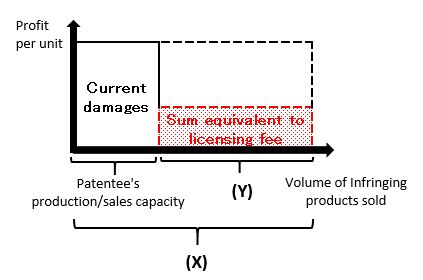In principal, the Japanese patent system adopts two-stage proceedings in examining patent infringement cases; a stage for examination on infringement and a stage for examination on damages. In the first stage, a court conducts proceedings on whether the patent in question has been infringed or not, taking into account invalidity of the patent. After the court finds infringement, the court assesses the amount of damages. Furthermore, the court affirms injunction once the court finds sufficient evidence of infringement, except in special exceptional cases. In other words, injunction relief brings advantages to patentees. On the other hand, courts affirm a relatively low amount of compensation for damages, which has often been criticized for being too small of an amount to cover the damages. There is no system where a defeated party should shoulder attorney's fees in Japan. On top of that, even in an exceptional case where the court orders a patentee to pay attorney's fees to an infringer based on the patentee's tort liability, the amount paid for attorney's fees is traditionally fixed at 10% to 20% of the compensation for damages.
A Revision to the Patent Law, which was enforced on April 1, 2020, reformed the method of calculation of compensation for damages. The revised patent law has greater benefit to patentees compared to the former method. However, please note that it is not a fundamental change to the law, but a subtle adjustment. We would like to describe a summary of the revised calculation method, referring to the latest notable court case (Note: the decision was rendered before the revision to the Patent Law came into effect).
Basic principles of standards for calculating the amount of compensation for damages
In Japan, the fundamental principles of compensation for damages are interpreted in accordance with Article 709 of the Civil Code (the so-called Difference Theory): "A person who has intentionally or negligently infringed any right of others, or legally protected interest of others, shall be liable to compensate any damages resulting in consequence". In other words, the amount of compensation for damages can be calculated as the amount by deducting the patentee's actual loss caused by the infringement from presumptive profit on the presumption that no infringement occurred. That said, if that is the case, it would turn out that the patentee is liable to excessive burden of proof. Therefore, the Patent Law sets presumptive provisions for that. The basic principles behind calculating the amount of compensation for damages are as follows.
Provisions before the Revision:
|
Article 102 (1) |
Profit of price per unit of the plaintiff's product multiplied by the number of infringing articles sold by the defendant (excluding those exceeding the plaintiff's actual production and sales capability) |
|
Article 102 (2) |
Profit obtained from selling infringing products by the defendant multiplied by the number of the units sold by the defendant (Profit of the defendant) |
|
Article 102 (3) |
The amount equivalent to a licensing fee multiplied by the number of units sold by the defendant (Note: A minimum amount of compensation for damages is provided as an unwritten rule.) |
Revised standards for calculating the amount of compensation for damages
- Article 102 (1):
This is calculated on the assumption that the number of the units sold by the defendant is X, and the amount that exceeds the capability of the plaintiff among X is Y, the damages for the portion under the plaintiff's sales capacity is calculated based on a formula of the profit per unit multiplied by the number of sales. The amount of damages for the portion beyond the plaintiff's capacity will be added as an amount equivalent to a licensing fee.
Before the revision; the plaintiff's profit per unit multiplied by (X – Y) units
After the revision; the plaintiff's profit per unit multiplied by (X – Y) units + an equivalent licensing fee multiplied by Y units

- Amount equivalent to a licensing fee in Article 102 (1)
(3):
The revised Patent Law clarifies the standards that calculation of compensation for damages as the amount equivalent to a licensing fee can be considered to add the amount of the licensing fee on the premise that other party infringes that patent. (Article 102 (4))
The IPHC Grand Panel decision regarding appeal case seeking injunction and compensation for patent infringement (Case No. 2019-(Ne)-10003)
The Intellectual Property High Court (IPHC) Grand Panel decision on patent infringement on a beauty instrument on February 28, 2020 is drawing attention as an example which applies the presumptive rule of the Patent Law Article 102 (1). In the first trial decision, the Osaka District Court approved 10 % of marginal profit considering the percentage of a patent's contribution to product sales. In addition, the Court ordered the defendant to pay compensation in the amount of 110 million JPY (1.1 million USD) in light of a 50 % deduction of the product sales volume made by the defendant, as the volume of which the patentee would have been unable to sell the patented products. Subsequently, both parties filed a request for appeal against the first trial decision to the IPHC.
In the IPHC Grand Panel decision, the IPHC approved 40 % of marginal profit considering the percentage of the patent's contribution to product sales, and ordered the defendant to pay compensation in the amount of 440 million JPY (4.4 million USD) in light of the deduction of 50% of the product sales volume made by the defendant, as the volume of which the patentee would have been unable to sell the patented products.
Among the number of the units sold, the IPHC approved 50 % as the volume of which the patentee would have been unable to sell the patented products. That said, the amount of the compensation for damages based on Patent Law Article 102 (1) turned out to be extremely high in comparison with the comparison for damages based on Patent Law Article 102 (2) because the amount of profit is measured by that of the plaintiff, not the defendant.
This means that this decision paves a way to change a calculation method of the compensation for patent infringement based on the price of legitimate patented products, from the method based on the reasonable price of counterfeiting products.
Comparison of the law with the US and Europe
According to statistics of the Deloitte Tohmatsu Group, which was a member of the working group of research and study for the Revision to the Patent Law, the U.S. marked the highest amount of approved compensation in patent infringement court cases among major jurisdictions,. In the U.S., the median value reaches 250 million JPY (2.5 million USD) and 35 % of the total cases are approved at over one billion JPY (10 million USD). In contrast, the median value is 23 million JPY (230 thousand USD) in Japan. There is a huge gap between the U.S. and Japan. Having said that, Japan is the third largest country following the U.S and the U.K. among the major jurisdictions.
However, in many patent infringement cases, attorney's fees come to over 30 million JPY (300 thousand USD). Considering that the compensation for damages is not enough to cover attorney's fees in many cases, further revisions to establish a patentee-friendly system are expected.
[Note 1 USD = 100 JPY]
The content of this article is intended to provide a general guide to the subject matter. Specialist advice should be sought about your specific circumstances.

